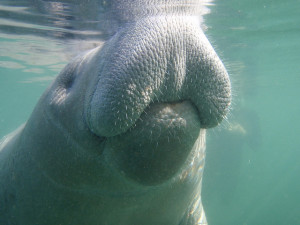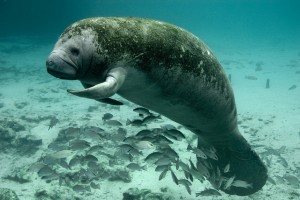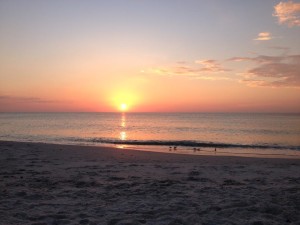We have much more to do and your continued support is needed now more than ever.
Protecting Florida’s Manatees from Harmful “Red Tide”
Basking in the south Florida sun, a skimboarder turned to my friends on the beach and eloquently stated, “Bro, your girls are getting eaten by manatees.”

I’m a native Floridian and have lived most of my life just a few steps from the Gulf of Mexico in the quiet paradise of downtown Naples, Florida. I spent every possible moment outdoors; so, I should have been prepared to identify what I saw out of the corner of my eye while swimming with my sister offshore, right?
Apparently not.
As soon as I glimpsed the two massive, amorphous gray blobs swimming towards me, my already active imagination flipped into overdrive and bypassed the obvious conclusion that the shapes were nothing but two whiskery manatees.
Naturally, I screamed at the top of my lungs and swam as fast as possible towards the shore, leaving my sister to the “mercy” of the strange, shadowy figures eight feet away. After several seconds of panicked swimming, I began to laugh hysterically, realizing the absurdity of my mistaken conclusion that these creatures were out there to eat me. I then turned around to enjoy the incredible sight.
In High Tide or Low Tide…But Not Red Tide
Though this interaction paints me in a rather embarrassing light, it was an extraordinary experience to have two peaceful manatees happen upon us so naturally.
Manatee populations have been suffering for decades due to human activities – we flock to coastal areas and replace natural shoreline environments with concrete developments – bringing the animals into contact with boat propellers and contributing to dramatic habitat destruction. While the mammal is currently listed as endangered, years of conservation efforts have improved manatee populations though grave threats still remain.

HABs can result when excess nutrients like phosphorus and nitrogen are added to aquatic systems, essentially fertilizing the algae and causing populations to increase exponentially. The bloom currently impacting these manatees is caused by a type of phytoplankton called Karenia brevis that produces toxins detrimental to both humans and marine wildlife. Manatees in Florida’s warm waters typically feast on sea grass, so when the phytoplankton settles on marine plants, the animals can ingest the toxins. The manatees then lose coordination and cannot surface to breathe.
This particular bloom has been referred to as red tide and it has already killed more than 240 manatees this year. This alarming figure already surpasses the previous record for algae-related manatee deaths in a calendar year, when 151 manatees died in 1996.
Protect the Gulf’s Wildlife

In Florida, one way to improve water quality in Gulf waters is by restoring America’s Everglades, particularly focusing on the Caloosahatchee River (C-43 Basin Storage Resorvoir) project and the elevation of Tamiami Trail. These two projects will improve the quality and quantity of freshwater flows into the Gulf of Mexico, reducing the amount of nutrient pollution entering coastal environments.
These recent manatee deaths highlight just how complex and interconnected water systems are, reminding us that our actions have incredibly far-reaching consequences. For the sake of Florida’s manatees and other wildlife, we need to restore the Gulf ecosystem.






















